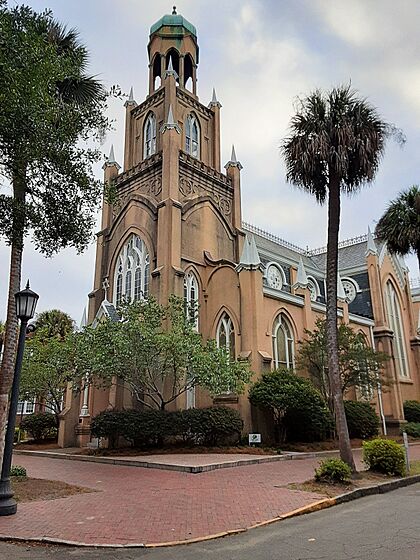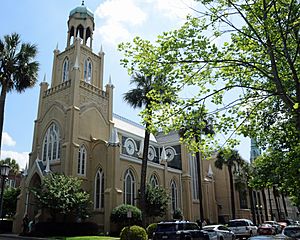Congregation Mickve Israel facts for kids
Quick facts for kids Congregation Mickve Israel |
|
|---|---|

Mickve Israel synagogue, in 2022
|
|
| Religion | |
| Affiliation | Reform Judaism |
| Ecclesiastical or organisational status | Synagogue |
| Leadership | Rabbi Robert Haas |
| Status | Active |
| Location | |
| Location | 20 East Gordon Street (also listed as 428 Bull Street), Monterey Square, Savannah, Georgia |
| Country | United States |
| Architecture | |
| Architect(s) | Henry G. Harrison |
| Architectural type | Synagogue |
| Architectural style | Gothic Revival |
| Date established | 1733 (as a congregation) |
| Completed |
|
| Materials | Gilded gold, marble, ivory |
Congregation Mickve Israel is a Jewish place of worship, called a synagogue, in Savannah, Georgia. Its name means "Congregation for the Hope of Israel" in Hebrew. It is located at 20 East Gordon Street, near Monterey Square. The site also has a museum about Jewish history.
This congregation was started in 1735 by Jewish immigrants from London. They were mostly Sephardic Jewish people from Spain and Portugal. It is one of the oldest Jewish congregations in the United States. The current synagogue building was finished in 1878. It was built in the Gothic Revival style. The building was added to the National Register of Historic Places in 1980. It is also part of the Savannah Historic District.
Since 1904, the congregation has been a member of the Union of American Hebrew Congregations. This group supports Reform Judaism, a modern form of Judaism.
Contents
History of the Congregation
How the Congregation Started
The congregation began in July 1735. It was first called Kahal Kadosh Mickva Israel. They soon rented a building to use as a synagogue. The group was founded by 42 Jewish people who sailed from London. They arrived in Savannah on July 11, 1733. This was just months after the colony was founded by James Oglethorpe. Most of these people were Spanish and Portuguese Jews. They had left England to escape the Spanish Inquisition. Many had been members of the Bevis Marks Synagogue in London. Rich Jewish people in London helped pay for this first group. They also helped a second ship carry more Jewish colonists to Savannah. The founders brought a special scroll called a Sefer Torah with them. This Torah is still used for special events at the synagogue today.
In 1742, during a war between Spain and Great Britain, Spanish troops landed nearby. Most of the Sephardi Jews left Savannah. They were afraid they would be harmed if captured. Only the Abraham Minis and Sheftall families, who were Ashkenazi Jews, stayed. They stopped renting the synagogue building. Instead, they held services at Benjamin Sheftall's home.
By 1774, enough Jewish people had returned to Savannah. They decided to formally restart the congregation. They met the day before Yom Kippur. The group agreed to hold services in a room that Mordecai Sheftall had prepared.
During the American Revolutionary War, the congregation did not hold formal services. On July 7, 1786, "K. K. Mickvah Israel" was reorganized. They rented a new space for a synagogue. About 70 people came to worship. Governor of Georgia Edward Telfair approved a charter for the congregation on November 20, 1790. The congregation still operates under this charter today. By 1793, the congregation had trouble paying rent. They gave up their leased space. Services were then held in members' homes. However, the congregation kept its formal structure and elected leaders.
In 1997, a recipe for charoset was found from the congregation. Charoset is a paste of fruits and nuts eaten during the Passover Seder. The recipe was from 1794. It described charoset as "a compound formed of almonds, apples, & C. Worked up to the consistence of lime."
Congregation Mickve Israel was the first Jewish community to receive a letter from a U.S. President. Levi Sheftall, the congregation's president, wrote to George Washington. He congratulated Washington on becoming the first President. Washington replied with a letter to "The Hebrew Congregation of the City of Savannah, Georgia." In his letter, Washington wished them well. He hoped they would continue to receive blessings from God.
First Synagogue Buildings
In 1818, Moses Sheftall and Jacob De la Motta worked to build a synagogue. The city of Savannah gave the congregation a plot of land. A small wooden building was built there. It was at the corner of Liberty and Whitaker streets. This building was dedicated on July 21, 1820. It was the first synagogue built in Georgia. A fire destroyed the building on December 4, 1829. But the congregation saved its important Torah scrolls.
Moses Sheftall led efforts to rebuild starting in 1834. A brick building was constructed on the same spot. It was dedicated in 1841. Reverend Isaac Leeser from Philadelphia led the ceremonies. Today, a bronze plaque in the sidewalk marks where these buildings stood. Reverend Jacob Rosenfeld became the congregation's first full-time spiritual leader in 1853. He served until 1862. For many years after, members led services themselves. Then, in 1873, they hired Reverend A. Harris.
Changes to Reform Judaism
Mickve Israel kept its Portuguese traditions for a long time. This was even as Reform Judaism grew in the United States. The congregation began to change in 1868. They added a choir with musical instruments. They also stopped observing the second day of festivals. Rabbi Isaac P. Mendes suggested slow changes. He led the congregation for 27 years, starting in 1877. In 1880, they stopped requiring a chuppah at weddings. In 1894, they removed the rule about wearing a head covering.
The congregation used a special Portuguese prayer book until 1895. Then, the synagogue published its own prayer book. In 1902, the congregation started using the Union Prayer Book. Mickve Israel joined the Union of American Hebrew Congregations (Reform) on January 10, 1904. One old Sephardi tradition still remains. They sing "El Norah Alilah" during the Ne'ila service. This is in the last hour of Yom Kippur.
The Current Building
Savannah's Jewish population grew. The congregation needed a bigger building. They planned for a new structure. The cornerstone for the current building was laid on March 1, 1876. The building's Gothic Revival architecture was designed by Henry G. Harrison. He was an architect from New York. He also designed the Cathedral of the Incarnation in New York. Harrison designed the synagogue in a shape often used for Christian churches. An unusual part is the tower. It has an open, gazebo-like top called a belvedere. Above that is a dome that looks a bit like Islamic designs. After the plans were set, the synagogue president received a letter. A woman from Pennsylvania commented on the design. She noted it looked like a Christian church.
A piece of land next to the synagogue was sold. This land had been set aside by Mordecai Sheftall in 1773 for a cemetery. Another part of the land was used for the Mordecai Sheftall Memorial in 1902. This building had meeting rooms and a religious school.
On May 7, 1933, many Jewish and Christian people gathered at the synagogue. They marked 200 years since Jews first arrived in Georgia.
The original Mordecai Sheftall Memorial became too small. A larger replacement building was dedicated on January 11, 1957. More changes were made to the three-story Sheftall Memorial Hall in 2003. These changes made space for the congregation's museum, library, shop, religious school, offices, and a banquet room.
Tours for Visitors
The synagogue is in the Savannah Historic District. It offers tours to visitors on weekdays. It is closed on Jewish and federal holidays, and on St. Patrick’s Day. The tour lasts about 45 minutes. There is a fee of $14 per person.
Gallery
See also
- Jewish history in Colonial America
- Moses Ferst, remembered by a stained-glass window on the northern side of the sanctuary










